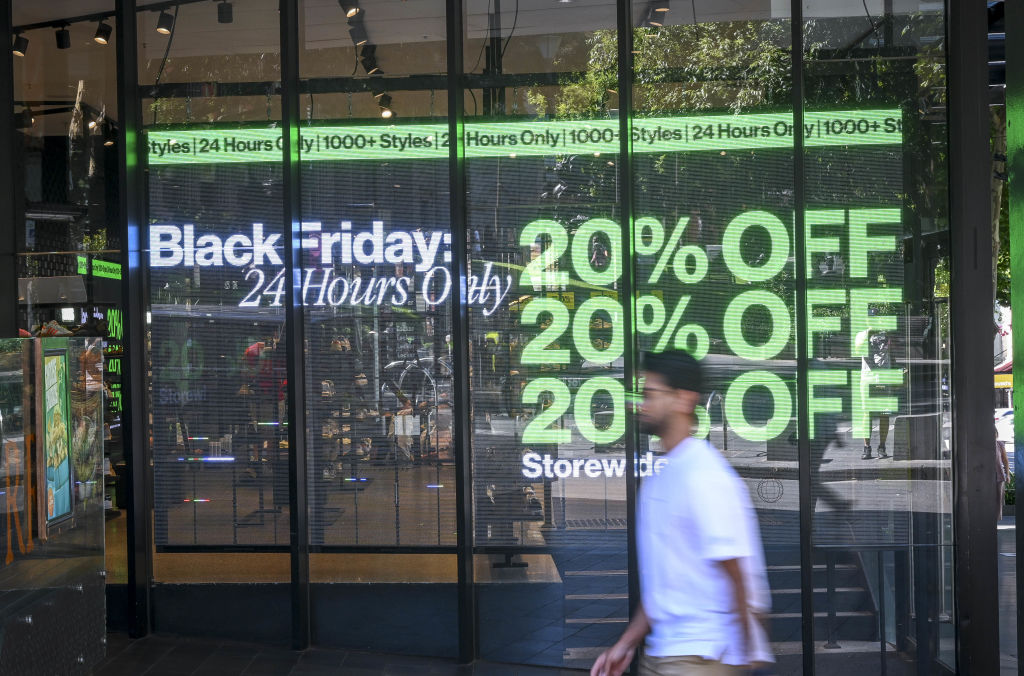
How Black Friday became the biggest shopping event of the year
Australians are gearing up to spend a record $6.8 billion over the four-day Black Friday to Cyber Monday weekend – a 4 per cent increase on last year, according to research by the Australian Retailers Association (ARA) in partnership with Roy Morgan.
It spells great news for retailers and a pressure test for the nation’s in-demand industrial property sector.
The traditional American retail event was adopted by Australian retailers in the early 2010s. Today, the revenue generated by the sales frenzy eclipses the traditional post-Christmas clearance week that starts on Boxing Day.
Releasing the research, ARA chief executive Chris Rodwell said Black Friday had cemented its place on Australia’s retail calendar.
“Shoppers are savvy and more deliberate – they’re waiting for big sales events like Black Friday to make larger purchases – but it’s not just about price,” said Rodwell.
“Australians are looking for value, reliability and a trusted retail experience.”
For the increasing number of online shoppers, a trusted experience translates into one click, and the product is on their doorstep within a day or two.
In reality, that one click translates into a package that requires sorting, storing, shipping, and delivery – the core of the industrial and logistics sector’s operations.
This year, the e-commerce penetration rate has reached an all-time high of 14.3 per cent of the total retail spend, according to the latest CBRE report, E-commerce and its Impact on Logistics Real Estate. In 2029, it is forecast to reach 17 per cent.
“As e-commerce continues to grow, competition among distributors and retailers for modern, high-quality logistics space in Australia will intensify,” said Sass Jalili, CBRE’s head of industrial and logistics, data centre research Australia.
“CBRE’s analysis suggests that for every $1 billion of e-commerce sales, an additional 70,000 square metres of logistics space is required. Based on this, we see a further 1.7 million to 1.8 million square metres of logistics space will be needed for e-commerce between now and 2030, which combined with other major growth drivers, exceeds the current supply pipeline.”
It’s clear to see how peak seasonal spending events, such as Black Friday, contribute significantly to the pressure on the industrial property sector. Faced with record-low vacancy rates and increasing rental prices in our capital cities, stakeholders in the industrial and logistics sectors are advocating for the construction of more multi-storey warehouses in critical infill areas.
Sydney remains the national leader in the industrial sector’s leasing activity. Tom Rourke, CBRE’s head of Western Sydney industrial and logistics, said while Perth and Adelaide had seen growth in both the demand and value of warehouses, the increase in Sydney land values and rental rates had been “very high”.
In prime locations, industrial rents were surpassing those for prime retail space, he said, citing a multi-warehouse development in Alexandria, South Sydney, which was asking $470 per square metre net.
“Location plays a big part in demand and supply – in your ability to service same-day or next-day delivery – so anything that is classified as infill is achieving a premium sale price or premium rent,” said Rourke.
“What they’re doing at Moorebank Intermodal (Precinct) is an excellent example of developing property specifically for e-commerce.
“It’s designed to bring product in from overseas, via the port, and then via rail to reduce truck movements on roads. And it’s in a key location for same-day, or next-day delivery to major metro areas.”
Currently Australia’s largest freight infrastructure project, the Moorebank development will provide 850,000 square metres of state-of-the-art warehousing in one of Sydney’s premium industrial areas at the intersection of key freight corridors.
Earlier this year, the precinct’s chief executive, James Baulderstone, said it would play “an essential role in modernising our nation’s critical supply chain by providing essential products to homes and families securely and affordably.”
A recent Cushman & Wakefield report and companion podcast stated a powerful case for the development of multilevel warehousing – to take the industrial and logistics sector “from scarcity to scale.”
Luke Crawford, the company’s head of logistics and industrial research in Australia, led the charge.
“While multilevel in Australia remains nascent, its continued rollout through a large supply pipeline will reshape investment strategies and influence how occupiers make location and leasing decisions,” his industry report said.
“To date, there have been approximately 110,000 square metres of multilevel warehouse space delivered in Sydney … Over the next two years, a further 180,000 square metres of multilevel warehouse space will be added to the market, while there is a potential for a further 1.4 million square metres in the long-term pipeline.”
Technology, such as advanced automation and robotics, is another factor that will propel change in the industrial and logistics sector, but at this stage, industry experts say the cost of such innovation is a deterrent for many businesses.
People power is still seen as the solution to managing peak retail periods, even for the world’s largest e-commerce platform, Amazon. The Australian arm of the company recruited an additional 1800 people in October to help pick, pack, and ship customer orders during the peak festive season.
“Automation is very expensive to implement, so it’s only the much larger retailers that are doing it,” explained Crawford. “Obviously, supermarkets are well advanced in that area and in some of the department stores there will be an element of it, but it’s not as advanced as, say, the Amazon fulfilment centre in Kemps Creek [in Western Sydney]. For a lot of businesses, people are still driving the pick-and-pack process.”
Crawford’s colleague Tom Barnier, the joint head of brokerage, logistics and industrial for Sydney South, agreed:
“There are still businesses doing extremely well through pick and pack. I know of a large online rag trader that is about to lease a substantial multilevel asset currently being built and its business is not automated, it’s not robotic. It still gets done traditionally, as in pick and pack and gets its product out quickly.”










